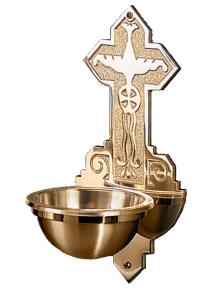

Q. 1. What is the purpose of the Holy Water fonts found at the entrance of Catholic Churches beside the doors?
A. 1. A holy water font or stoup is a vessel containing holy water which is usually placed near the entrance of a Church. It is also called a bénetier. It is often placed at the base of a cruxifix or religious representation. It is used to make the Sign of the Cross using the holy water upon entrance of the church.
The Holy water is blessed by a priest. Many Christians believe that it is a reminder of their baptismal promises.
It is a common belief in the Catholic Church that the use of holy water as a sacramental protects the person against evil.
In the Middle Ages the power of holy water was considered so great that in some places fonts had locked covers to prevent the theft of holy water for unauthorized magic practices. The Constitutions of Archbishop Edmund Rich (1236) prescribe that "Fonts are to be kept under lock and key, because of witchcraft (sortilegia). Similarly the chrism and sacred oil are kept locked up."
In Catholicism, holy water, as well as water used during the washing of the priest's hands at Mass, is not allowed to be disposed of in regular plumbing. Roman Catholic churches will usually have a special basin (a Sacrarium) that leads directly into the ground for the purpose of proper disposal. A hinged lid is kept over the holy water basin to distinguish it from a regular sink basin, which is often just beside it. Items that contained holy water are separated, drained of the holy water, and then washed in a regular manner in the adjacent sink.
Holy water fonts have been identified as a potential source of bacterial and viral infection. In the late 19th century, bacteriologists found staphylococci, streptococci, coli bacilli, Loeffler's bacillus, and other bacteria in samples of holy water taken from a church in Sassari, Italy. In a study performed in 1995, 13 samples were taken when a burn patient acquired a bacterial infection after exposure to holy water. The samples in that study were shown to have a "wide range of bacterial species", some of which could cause infection in humans. During the swine flu epidemic of 2009, Bishop John Steinbock of Fresno, California recommended that "holy water should not be in the fonts" due to fear of spreading infections. Also in response to the swine flu, an automatic, motion-detecting holy water dispenser was invented and installed in an Italian church in 2009.
The traditional Latin formula for blessing the water is as follows:
English translation:
"I exorcise thee, creature of water, in the name of God the Father almighty, in the name of Jesus Christ, his Son, our Lord, and in the power of the Holy Spirit, that you may put to flight all the power of the enemy, and that enemy and to root out and, along with his fallen angels through the power of our Lord Jesus Christ, who shall come to judge the living and the dead and the world by fire. O God, who for the salvation of the human race has built Thy greatest mysteries in the substance, in your kindness hear our prayers, and with the element to this, for many kinds of purifications of his well-prepared, the power of Thy blessing, Serve it; the creation of Thy mysteries, serving as an agent of divine grace; is sprinkled with this water in their houses or in the buildings of the faithful, that whatever might be free from all uncleanness, he is freed from every harm. It is not no pestilent spirit, no taint of corruption; let all the wiles of the lurking enemy; or to provide for the safety and peace of the inhabitants of that which is, and if there be any, by the sprinkling of this water, so that health, through the invocation of Thy holy name, made secure against all attacks. Through the end."